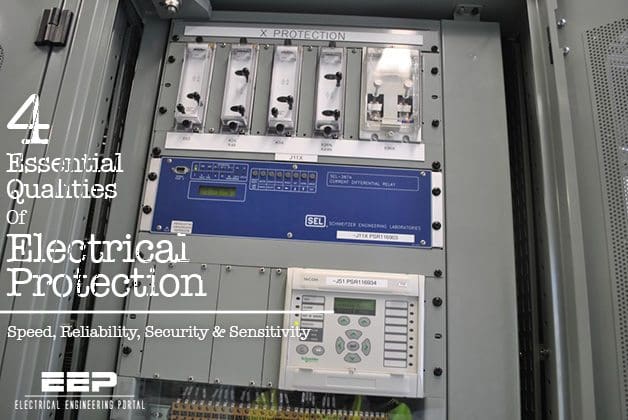Clik here to view.

4 Essential Qualities Of Electrical Protection (on photo protection relat panel by powersystemsmasters.com)
Fundamental Protection Requirements
In generating stations, all electrical circuits and machines are subject to faults. A fault is generally caused by the breakdown of insulation between a conductor and ground or between conductors due to a variety of reasons. The result is a flow of excess current through a relatively low resistance resulting in severe damage unless cleared quickly.
Let’s see the four main building blocks that are used to meet fundamental requirements of electrical protection:
1. Speed
When electrical faults or short circuits occur, the damage produced is largely dependent upon the time the fault persists. Therefore, it is desirable that electrical faults be interrupted as quickly as possible.
Since 1965, great strides have been made in this area. High-speed fault detecting relays can now operate in as little time as 10 milliseconds and output relaying in 2 milliseconds. The use of protection zones minimizes the requirement for time-delayed relaying.
2. Reliability
The protective system must function whenever it is called upon to operate, since the consequences of non-operation can be very severe. This is accomplished by duplicate A and B protections and duplicate power supplies.
Clik here to view.

Examples of protection relays – Micom, Ref and Siprotec
3. Security
Protections must isolate only the faulted equipment, with no over-tripping of unaffected equipment. This is accomplished by the use of over-lapping protection zones.
4. Sensitivity
On the other hand, the protection must not be too sensitive and operate unnecessarily.
Some loads take large inrush starting currents, which must be accommodated to prevent unnecessary tripping while still tripping for fault conditions. The ability of relaying to fulfil the sensitivity requirement is improved through the use of protection zones.
Introduction to Protection and Control (WEBINAR)
This ABB’s webinar will define power system protective relaying and its purpose. A general overview of key concepts, protective relay classifications, operating principals, operating reliability and relaying philosophy will be presented.
Also provided is a brief review of terminology, ANSI C37.2 device function numbers and IEC 61850 logical nodes (device function models).
Cant see this video? Click here to watch it on Youtube.
Reference: Science and Reactor Fundamentals – Electrical CNSC Technical Training Group